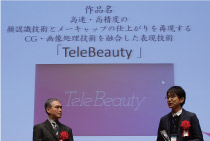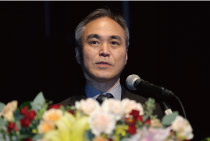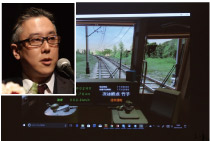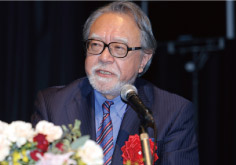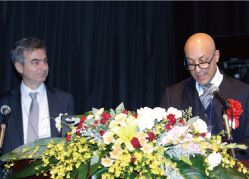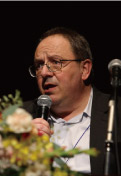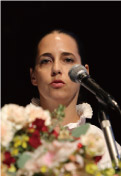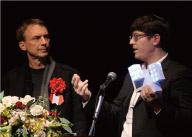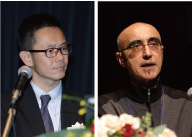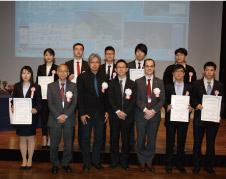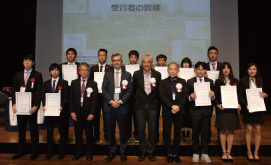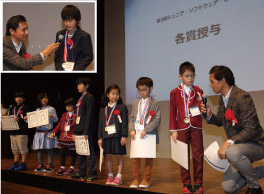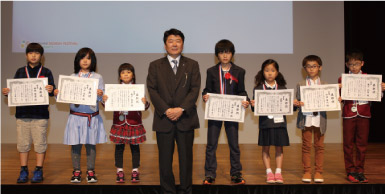| Day2
11/16 Thu. |
The 3rd State of the Art Technologies in Expression Association / Latest Contents Sessions / CRAVA Inc. |
| The 1st Hagura Award and the Expression Technology Test |
| Day2 started with a presentation "Support for expanding the usage
of state of the art technologies in expression" by Mr. Satoshi Machida,
President of The State of the Art Technologies in Expression Association. As a new activity of the association, Mr. Machida announced "Expression Technology Test (Construction ICT)". The purpose of this examination is encouraging people to learn knowledge and technology about expression and communication using IT in each field in order to develop human resources required in the current society. The result announcement and award ceremony of Hagura Award were also conducted. (Expression Association Report (Japanese)) The commemorable first Hagura Award was given to "Tele Beauty" by Shiseido Company, Limited, which had attracted attention in internet news before. The image process and CG process of its makeup simulator, which was its sales promotion tool, are integrated in TV conference system. This challenge for the high social technology was highly evaluated. It is not a business but a contribution to the society in terms of "the cosmetic company encourages not to use makeup". Following the Hagura Award, three encouraging prizes were announced. The VR Technology Award was given to "Luminescent Tentacles" by Prof. Akira Nakayasu, Kanazawa College of Art. in addition to technologies used in software and hardware, its characteristic actuator reproducing creatures' movement in nature was highly evaluated. For the Video Technology Award, "Venus Statue at Nihonbashi Mitsukoshi. Installation of sound and light" created by Prof. Toshiyuki Amano, Wakayama University was selected. Normally, we must prepare images for projection mapping in advance, but this technology configures an algorithm for camera image process without prepared image and projects the image in real time. This technology is expected to be used in industry in addition to entertainment. "Expansion of new image expression for sports and sightseeing using omnidirectional camera image" created by Prof. Masami Okyudo, Wakayama University won the Expression Technology Promotion Award. A technology of projecting at diagonal angle is used in this work. VR image and system for dome-type screens are expanding now. The deciding factor of this work for the award was its new display method of omnidirectional public viewing, contribution to sightseeing business, and possibilities. |
|
| The Latest Case of Game Development Using VR |
| After the International VR Symposium, which is written below, Mr. Kurato Kazuki, President of CRAVA Inc. gave a presentation named "VR game development and future vision". He introduced a collaboration of UC-win/Road and online game, and talked about the reproduction of expression and movement of fire in a lava stage, the data of coin collecting game for driving simulator, and the fantasy world including flower roads. In addition, he explained the technology to convert camera image of clay model to 3D model data and a method to create real-time graphic data by transparentizing the road section with the alignment modeling of UC-win/Road. He also showed images of "Train Simulator VR" that can be experienced by the collaboration with HMD and "Kurogane" used with PlayStation VR. |
|

| Special Lecture by Mr. Masayuki Tamaki, Popular Sports Commenter |
| Conversion from "Physical Education" to "Sports", Expecting Change in Awareness of Society
|
|||||||||||
|
The 10th International VR Symposium
|
Day2 |
Competition of Enterprising Development through Hackathon Using UC-win/Road
After the special lecture, "The 10th International VR Symposium" started. Prof. Yoshihiro Kobayashi, Leader of "World 16" (Arizona State University and Director of FORUM8 Arizona) acted as facilitator. First, he summarized the overview of World 16 project in which 16 university scholars from diverse fields in various countries took part, positioning of the workshop held every summer and symposium held every autumn to present research results of the members, as well as the points of activities in the project so far, which had its 10th anniversary this time. In 2017, a summer workshop was held in Massachusetts Institute of Technology (MIT). As its assignment, hackathon was set up to work with engineers of FORUM8 using UC-win/Road. After the members exchanged ideas, they were divided into teams. They kept on examination and development for 2 days, and made presentations of their results on the third day. 4 teams of them took part in the symposium to present the results of the summer workshop in a more upgraded form, according to him.
On behalf of the remaining 2 teams which were unable to participate this time, Dr. Kobayashi mentioned their work as follows: 1) Prof. Thomas Tucker and Prof. Dongsoo Choi (both from Virginia Polytechnic Institute and State University) explores a method for the process from obtaining point cloud data to creating 3D models in a short time. The inside of the MIT office is scanned with a laser using LiDAR to obtain 3D point cloud, which are meshed. Then the created 3D models are visualized as VR spaces using UC-win/Road. 2) Prof. Wael Abdelhameed (University of Bahrain) applies it to excavational research actually being conducted in Bahrain. He tries to compare excavational data in time series using UC-win/Road Micro Simulation Player.
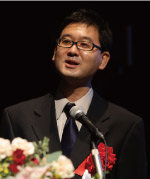 |
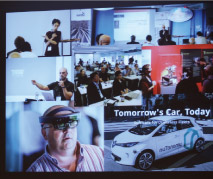 |
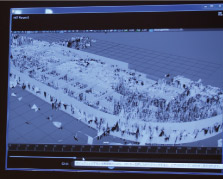 |
| Prof. Yoshihiro Kobayashi, Leader of "World 16" | ||
The first presentation of World 16 members was made by the team of Prof. Kostas Terzidis (Tongji University) and Prof. Amar Bennadji (Robert Gordon University). Each of them had his own idea separately. Then they thought of an application that integrates these two ideas. In specific, Prof. Bennadji wants to create interactive environment for tourists by creating many kinds of stories related to places such as buildings nearby. On the other hand, Prof. Terzidis hopes for developing a story telling system that pleases young children who have become tired in the car while driving. Together, they proposed a mechanism for users to get suitable information depending on the means of transportation, purpose, or situation when they approach to a specific place in traveling by car or on foot, by preparing in advance various kinds of contents such as places themselves, and also food, fashion, movies, and music that are useful for users ranging from children to adults, and by utilizing AR (augmented reality) technology or neutral networks. They also mentioned its advantage of allowing the users to feel bodily sensation on VR.
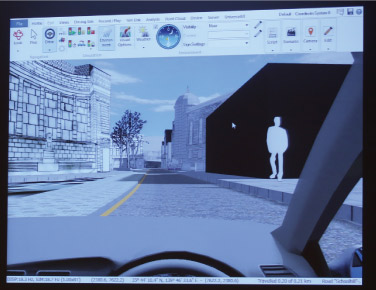 |
|
Next, Prof. Paolo Fiamma (The University of Pisa) and Prof. Ruth Ron (Shenkar College of Engineering, Design and Art) made presentation of their research on possibility of a new application to visualize various pieces of information according to their specialties by linking them with 3D models of buildings, using the functions of UC-win/Road and OpenMicroSim. Two years ago, Prof. Ron tried to visualize the change in temperature of environment over time. To do so, she obtained data of the temperature change by shooting images of the facade of a residential building with a thermography camera every three hours. She texture-mapped the data on the building model on UC-win/Road using OpenMicroSim. This time, she introduced her attempt to focus on the people living there. Pro. Fiamma, on the other hand, searched for new possibility of a digital tool to support the needs in the fields of architecture and constructing in Europe. This time, he proposes an approach for companies to select sets of elements that satisfy their needs during the constructing process, and visualize them along the time base, by providing UC-win/Road with wide variety of parametric information.
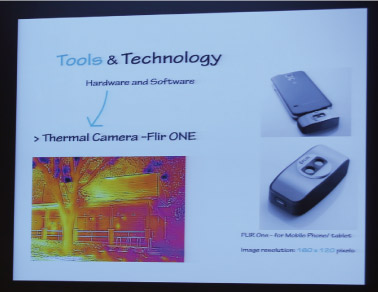 |
|
||||
The third presentation was made by the team of Prof. Matthew Swarts (The Georgia Institute of Technology) and Prof. Marc Aurel Schnabel (Victoria University of Wellington). They are developing design interfaces for the users who use different applications or HMI to connect with UC-win/Road in an interactive way and operate and design 3D VR in cooperation. Prof. Marc Schnabel depicts the "new environment" he aims at like this; it has a server that supports all different interfaces, allowing the users who create 3D models in various ways to connect to it by way of the Web interface, and consequently to develop VR environment of UC-win/Road or do VR design in cooperation, and also to enjoy games using smartphones etc. Prof. Swarts not only mentions the advantage of integration using JavaScript in the development process but also pays attention to its side as a tangible user interface. When the user connected to it upgrades a 3D model, it is of course reflected in the VR within UC-win/Road. He also mentions the possibility of the function to expand to physical building / urban spaces.
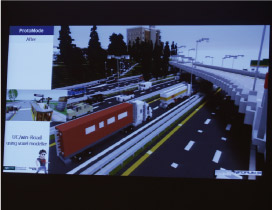 |
|
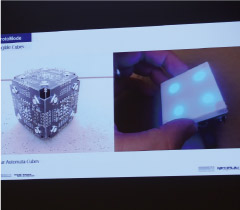 |
Prof. Tomohiro Fukuda (Osaka University) and Prof. Marcos Novac (University of California, Santa Barbara) made the final presentation of World 16. It was about development of framework for image processing of 3D models, which they are working on in cooperation. As an approach to unite technology, humanity, engineering, mathematics, art, and science to integrate into one environment on UC-win/Road, Prof. Novac looks back on the progress of incorporating the idea of segmentation into the creation process of VR based on their research subjects so far such as machine learning and artificial intelligence. Prof. Fukuda explained the method of segmentation, in which processing is done by dividing data for every object, and its advantages by giving examples such as artistic representation and scientific explanation made possible by this method. On the contrary, in the cases of using the actual world and VR together by relating them with each other such as automated driving and Smart inspection system for infrastructure facilities, there had been some constraints so far such as causing errors. Considering this, he explained the functions of the newly extended segmentation.
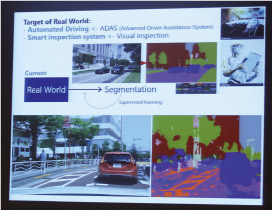 |
|
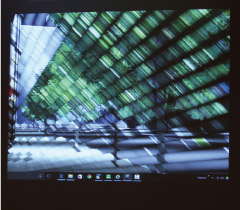 |
After the presentations of World 16 teams, Pencreach Yoann, Executive Officer and VR Development Manager of FORUM8 outlined how he estimated the presented projects. At the same time, he introduced functionality extension of UC-win/Road that reflected part of the development results as well as some related functions under development.
Finally, Prof. Yoshihiro Kobayashi summarized the symposium. He mentioned the main points of each of the presented four projects, and expressed future prospects to further examination in the concerned areas.
(Written by Takashi Ikeno)
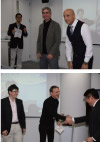 |
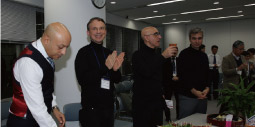 |
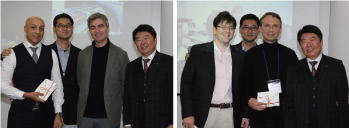 |
| Award ceremony held at the party after all the sessions were over. |
Reception of Academy Encouragement Prize: (left) Prof. Bennadji and Prof. Terzidis, (right) Prof. Swarts and Prof. Schnabel |

|
The 5th Student Cloud Programming World Cup Open presentation & Award Ceremony |
Day2 |
Driving alert system by deep learning system won the World Cup Award
| The Student Cloud Programming World Cup is a competition of software using
communication systems of UC-win/Road and VR-Cloud®, and its 5th competition
was held this time. "World Cup Award" was given to "Car that Knows Before You Do via Deep Learning" by "VAEGIS" from "Kookmin University (Korea)". The system proposed in this work is an alarm system that analyzes driver's behaviors by using AI deep learning and inform possible hazard in advance. This allows drivers to avoid or prepare for the danger, and it results in the accident prevention. For this purpose, they equipped a simulator with cameras, eye and head trackers, and CAN interface. They develop a sensory-fusion deep learning architecture which jointly learns to predict and fuse multiple sensory streams learn the model and integrate it with simulation software. Some other works won the honorable judge award. You can check other nominated works and the details from the banner below. |
|
|
The 7th Student BIM & VR Design Contest on Cloud Open presentation & Award Ceremony |
Day2 |
Sustainable development plan in Yangon by National University of Kaohsiung won the World Cup Award
| The theme of the 7th "Student BIM & VR Design Contest on Cloud" was to provide urban development plan that makes advantages of historical architectures and rich green and lakes, while solving issues such as traffic jam, health problem caused by flood, and power shortage in Yangon, a big city in Myanmar. The best "World Cup Award" was given to "Yangon green labs" created by "Living labs" from National University of Kaohsiung in Taiwan. Green finger system that allows "green" in Yangon located in the tropical monsoon climatic area spread into streets is combined with the concept of "sponge city" to improve the local flood problem. The traffic diversion system (partially undergrounded) is introduced in this plan in order to solve the congestion in the cities. xpswmm is used for improving flood situations, and "UC-win/Road" analysis and simulation are used to study the traffic diversion process in order to conduct a sustainable urban development in Yangon known as a garden city. |
|
||
| The Excellence Award was given to "Golden Hub" created by "Three
People Studio" from National University of Kaohsiung. You can check other nominated works and the details from the banner below. |
|||

| Junior Software Seminar | |
VR works created by elementary and junior high school students enhanced the quality more.
| With the cooperation of The Association of State of the Art Technologies in Visual Expression, FORUM8 held "Junior Software Seminar" for elementary and junior high school students in every long vacation in winter, spring, and summer. This competition was open for those who participated to the Junior Software Seminar. VR works created with "UC-win/Road" were enhanced more than last year, six works were awarded to Gold Prize, three to Silver Prize, and six to Bronze Prize. The 3rd award ceremony was held on 16th November, and the presenter Mr. Yuji Abe interviewed each winner. The unique works selected as Gold Prize with themes of such as starry city, animal Olympics, and time travel, etc. made VR professionals at the venue smile. Awarded works list can be seen from the banner below. |
||||
|
||||
In these contests, we received many excellent works from overseas and hence the award ceremony had a very international touch. In particular, Chinese teams occupied the majority of the CPWC ranking, and in VDWC, the participants from Taiwan and Vietnam notably won the prizes. By looking at the award-winning projects from recent 3D VR Simulation Contests on Cloud, it appears that works demonstrating an application of UC-win/Road in the field of safety and security are increasing, while the concept of landscape simulation that were dominant in many of the works from previous years are fading out. Many works have given us a whole host of helpful hints on how the future VR technologies ought to be.

